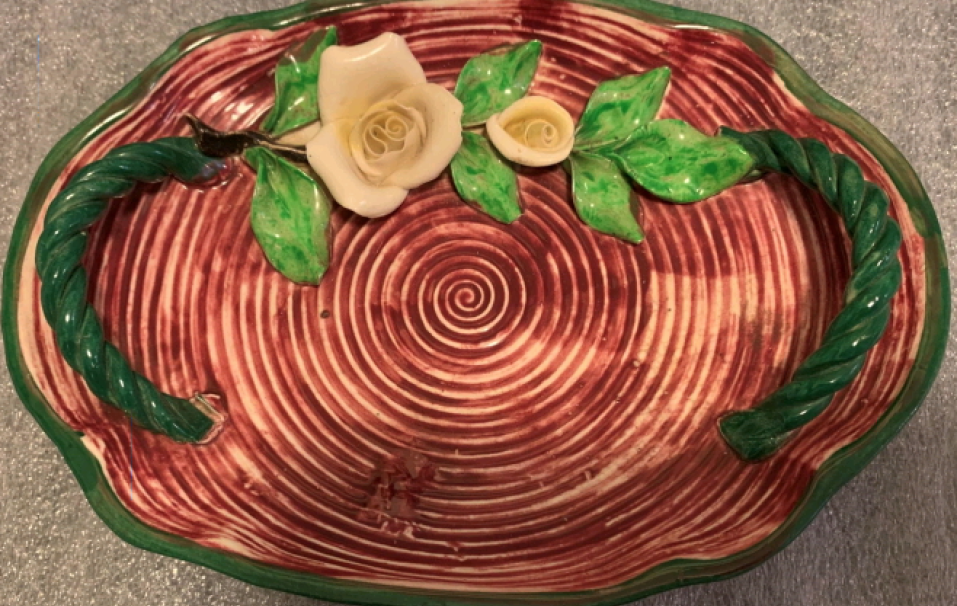By Margo McCutcheon, Educator, Sam Rayburn House State Historic Site
Many of us have items made in another country. Trade between parties near and far isn’t a new phenomenon, as the vague school memories of the Silk Road tickling your brain right now can attest. Refusing to go against basic human nature, the Rayburn family acquired things made in other places around the world because they, like most people, wanted to have things.
Before I begin to describe the items in our display case, I need to explain a little bit about the history of stamping objects with the name of the place where they originated, and that gets into everyone’s favorite topic: tariffs. The McKinley Tariff Act of 1890 made it a law that products imported into the United States had to be labeled with the products’ country of origin. Westerners used the name “Japan,” but the Japanese used the name “Nippon” or “Nihon” for their country, so Japanese exporters wrote “Nippon” or “Nihon” on their products after the McKinley Tariff became law.
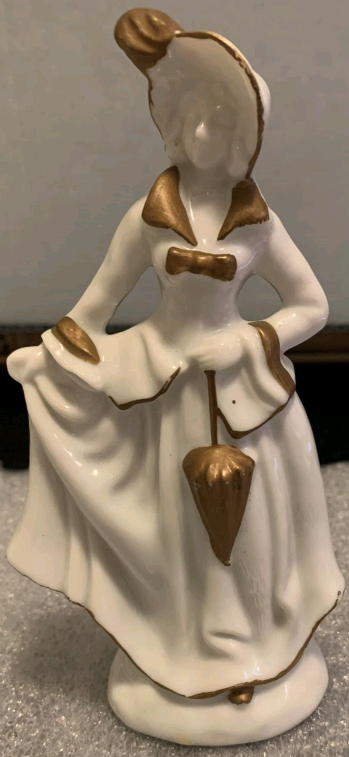
In 1921, the U.S. decided that all Nippon products had to change their branding from Nippon/Nihon to “Japan.” Although there may not be a concrete date when the labeling changed from “Nippon” to “Japan,” collectors of Japanese products can use 1921 as a starting point to begin dating their Japanese collectibles. Another helpful collection dating tip came after World War II (1939-1945). Allied forces under General Douglas MacArthur occupied Japan while rebuilding and remaking the economy and government of the nation. MacArthur ordered that products exported from Japan be marked with “Made in Occupied Japan” or “Occupied Japan.” This occupation lasted from 1945-1952, meaning that collectors have another reference point for their items. However, some fake “Made in Occupied Japan” items do exist. Products from occupied Japan were not meant to spread authentic Japanese culture, but rather to appeal to American consumers in the broadest ways possible.
Using this history and the lifespan of the Rayburns who lived at our site, we can better determine the date range of our artifacts. Of the 12 items in our exhibit case, all but four of the objects have writing indicating that they were made in Japan. Within these four, online searches indicate that one probably was made in Japan. The others appear to be inspired by Japan or other East Asian cultures. Although East Asia is by no means a small geographic area, we want to acknowledge that the items not specified to be made in Japan might have been made elsewhere or manufactured by American companies to appeal to American ideas of an Asian place, whether or not those ideas were accurate. Let’s begin by talking about the four items of mysterious origin.
The Three Wise Monkeys resin figurine that we have in our exhibit case does not come with a maker’s mark, but the story of the wise monkeys has an interesting connection to Japan. You might know the Three Wise Monkeys better as the “see no evil, hear no evil, speak no evil” monkeys. This Buddhist teaching essentially posits that we will be spared from evil if we do not hear, speak, or see evil, and it might have made its way to Japan in the eighth century via China. Those who followed Koshin, the Japanese folk religion, eventually carved the wise monkeys at the Toshogu Shrine in Nikko in Japan.
How did this saying come to be personified through monkeys? The Japanese translations of this saying equate to mizaru (see no evil), kikazaru (hear no evil), and iwazaru (speak no evil). The word for monkey in Japanese is saru, which can be modified to be zaru. So, the Japanese people used zaru to become a play on the words of the saying, creating monkeys that covered their eyes, ears, and mouth. The names of the monkeys are Mizaru, Kikazaru, and Iwazaru, by the way. Our monkey figurine is one piece with three distinct monkeys with their various head areas covered by their hands. The monkeys are wearing red, blue, and green jackets, with the blue jacket having some sort of flower pattern in white on the back.
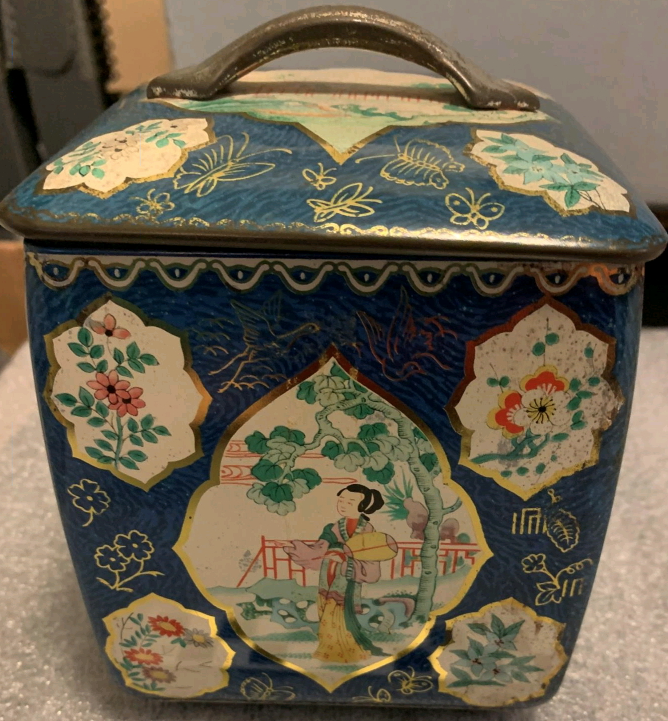
A decorative tea caddy
A decorative tea caddy and a bonbon dish seem inspired by Asian culture, but do not have a maker’s mark of any kind. Those who could afford to purchase tea in England during the 18th and 19th centuries put that tea in a tea caddy (the word “caddy” might have derived from the word for the Chinese pound, “catty”). Tea from China was such a valued commodity that buyers locked the tea away in a tea caddy to protect it from suspected thieves, mainly servants. Tea caddies were first made of porcelain, but then became available in other materials.
The Rayburns had a tin tea caddy with two patterns repeated on alternating sides of the cubed tin. Each side of the tin and its lid has five separate portrait areas, four in the corners and a larger portrait in the middle. The golden-edged portraits in the corners contain different types of flowers in the same positions around each side of the tin, but there are slight differences in those images depending on which side of the tin you look at. There are only two different types of middle portraits, but they alternate around the four sides. The portraits depict a similar yet different person walking through similar but different countryside scenes while holding what appears to be an instrument, possibly a biwa (Japanese lute) or a pipa (Chinese lute).
Painted or stamped all round the blue water-like coloring of the tin are small, gold-colored depictions of flowers, leaves, insects, and animals. A small, hexagonal ceramic bonbon dish with a white underside has a colorful scene hand painted with flowers and an inset nature scene. A red and gold-flaked border around scalloped edges lead into pink and green flowers and leaves on a white-yellow background. The inset scene depicts a woman and child walking along the water’s edge with a house, forest, and mountain in the background. Bonbon dishes typically hold small sweets or after-dinner snacks, so visitors to the Rayburn household found a nice surprise waiting for them once they reached the bottom of this bowl.
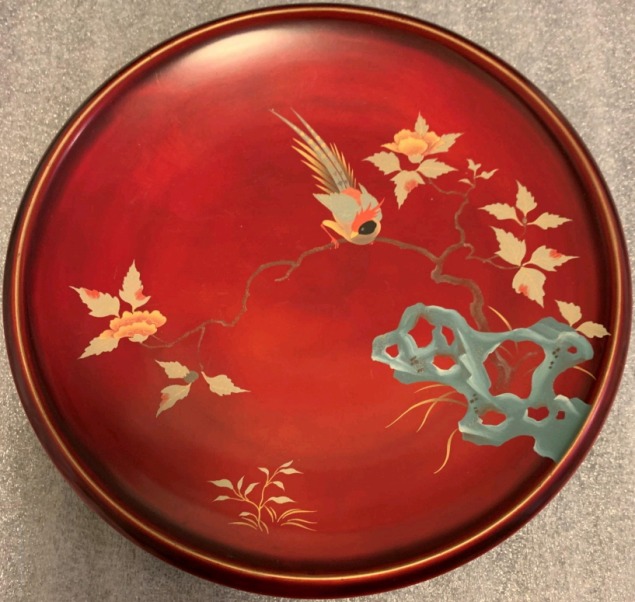
The final piece in our exhibit case that doesn’t explicitly say it was made in Japan is a set of six spoons. But these aren’t just any spoons, these might be sterling silver Japanese bamboo iced tea spoons—at least, that’s what various online marketplaces call them. Iced tea spoons are long spoons created to stir sweeteners around iced tea in the tall glasses that iced tea is typically served inside. The bowl ends of the Rayburn spoons have a flower design, possibly a lotus, and scalloped edges. A long, thin handle features five protrusions that appear to be a wire wrapped around the handle twice.
These protrusions divide the handle into sections and give the appearance of a bamboo pole. Each spoon has a charm on the tip in the shape of some object from Japanese culture: a pagoda, a sitting person (possibly a soldier or a deity from Buddhism, Shintoism, or Taoism), a Shinto Shrine, a Japanese fan (there are two types—a rigid fan is called an uchiwa and a folding fan is called sensu), a Kabuki performer or a geisha, and a single story building like a dojo or a chashitsu (a tea room or house). An online search will show you just how many Japanese bamboo spoons there are, and some have different bowls than ours while others have different charms at the tip of the spoons. Whether or not our spoons were made in Japan, they were definitely inspired by Japanese culture and probably made with American consumers in mind as iced tea was common in the U.S.
The majority of the Japanese items were likely purchased for decoration rather than practical use. For instance, there is a metal trumpet vase dated from 1921-1950. The thin metal, possibly pewter, making up the vase makes the vase feel more delicate that it might look. Several embossed designs around the vase may tell a story. All around the vase are leafy designs, but every now and then there appears to be a brick structure or diamond pattern thrown in. There are people in different scenarios at various points around the bottom of the vase as well as its sides. One part has a man holding a shovel and facing a woman holding a bag. Another shows a woman speaking to a man sitting on a box. Along the bottom of the vase is a ship on water. This vase could be describing a journey across the sea or the beginnings of a settlement.
A larger, urn-shaped glazed ceramic vase from the same date range is much more colorful. A cream-colored background makes the green, blue, brown, red, and yellow colors of the vase pop. Raised designs around the vase feature flowers, birds, and cherubs. Both of these vases have very different designs but could be used for the same purpose—displaying flowers. However, the Rayburns could have bought these vases simply because they liked the design and wanted to put them around the house, not to display flowers.
A small decorative plate/dish also seems built for display rather than use. This oval dish has a red spiral design on its top with two rope-shaped green handles and a green rim, evoking the image of a red flower or rose. Along one end between the two handles is a pattern of leaves and white roses. These ceramic roses are popping out of the plate, and their petals are just as thin and fragile as you think they are. Due to the feeling that I could break these roses without really trying, I imagine that if you did actually place jewelry or other small items on this object, you would have to be very careful about how you place them.
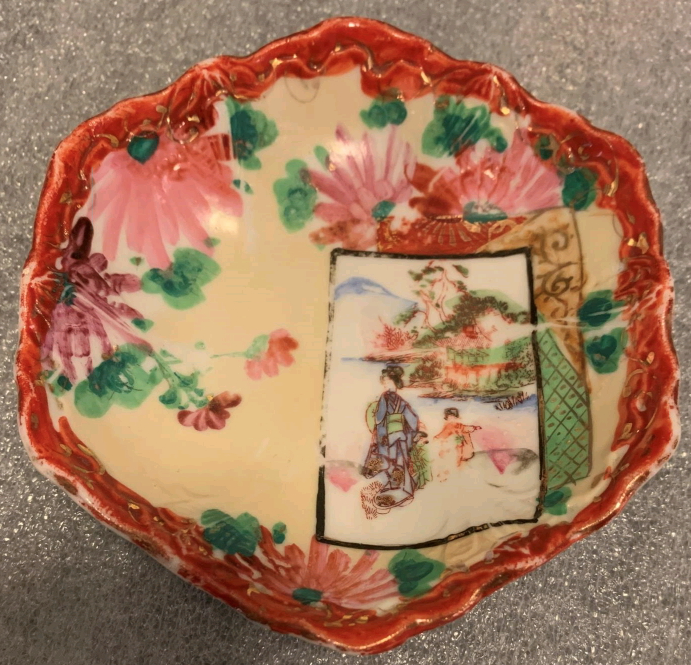
A small, hexagonal ceramic bonbon dish with a white underside has a colorful scene hand painted with flowers and an inset nature scene.
On the underside of the dish is a mark reading “Marco Japan,” but the internet is scarce on the details of this manufacturer. A company called Marco Japan does currently sell water boilers and coffee brewers, and you can find plenty of people selling Marco Japan china, but actually finding information and production records for the company itself appears futile. From the time frame of occupied Japan (1945-1952), we have a Maruni plate with a lacquerware metal base. This item was hand crafted and painted in Japan, and is quite striking in appearance due to its rich colors and textures. Bright shades of whites, yellows, blues, and pinks decorate a large plate covered in a deep red. The bird on the branch could be a creation of the artists who made the plate, or it might be a Japanese bird such as a Japanese Paradise Flycatcher or a type of woodpecker. Because the plate doesn’t appear to have any signs of distress, the Rayburn family might not have used it for eating or placed anything on it at all.
Two more decorative pieces are in the display case. A circular, wooden plant stand has the words “Made in Japan” neatly printed on its underside, although the words are the same color as the wood so it is hard to discern. Four small rectangular feet hold up the stand. The bottom ring of the stand includes intricate carvings that flow all the way around the object. A ceramic woman wearing mid-1800s clothing is colored completely in ivory accompanied with gold details. A partially faded maker’s mark contains the barely legible text, “in Japan,” in red letters around a double-circle image with a short line protruding from it.
Two websites about Japanese porcelain markings indicate that this partial marking was likely that of Yamashiro Ryuhei, who later changed his name to Maruyama Toki Yamashiro Ryuhei. His marking looks like the peace symbol within a circle, which matches the partial symbol on the colonial woman. The Rayburns may have had an interest in colonial imagery based on other objects in the home, especially two colonial bookends that look very similar to this figure and that were also made in Japan (you can spot the bookends in Medibel’s room in the Rayburn House).
The final two objects in our display are a brass cup and a brass desk calendar. Being the Speaker of the House of the United States of America, or a relative of said Speaker, does not make you immune to the allure of a souvenir cup. Whether Sam Rayburn picked up this cup upon his first trip to Austin as a young state congressman or whether a friend sent this to the Rayburn family, we are in possession of a weighty souvenir cup from Austin, Texas. Metal reliefs of the Congress Avenue Viaduct, the Governor’s Mansion, and the State Capitol appear around the cup.
The brass desk calendar is actually a perpetual calendar. Perpetual calendars typically refer to watches that don’t have to have their date set until the year 2100. The year 2100 will not be a leap year, so these perpetual calendar watches that are programmed to anticipate leap years would add a day incorrectly. We may take for granted that leap years occur every four years to accommodate the length of time it takes the Earth to complete one full rotation around the sun, but a leap year actually has to be divisible by 100 and 400 to be a leap year in order to keep us super accurate about the length of time we go around that really big star. The year 2100 is not divisible by 400 to a whole number, so all of you leap year babies can anticipate being teased about having to wait even longer for your birthday in about 77 years. Obviously this brass desk calendar is not a watch, so its perpetual ability lies in the fact that it doesn’t show a year. You can turn some knobs and flip the large domino-shaped display to show the current date, month, and day of the week. We always have this calendar set to a very important date—January 6—and I am going to be mean and make you find out yourself why that date is important (hint: this date has to do with something that happened about a century and a half ago, not anything that happened within the last few years).
There are plenty more items made in Japan or inspired by East Asia in the Rayburn House. What we choose to place in our exhibit case throughout the year shows just a little of the houseful of memories that we are able to care for with your support.

